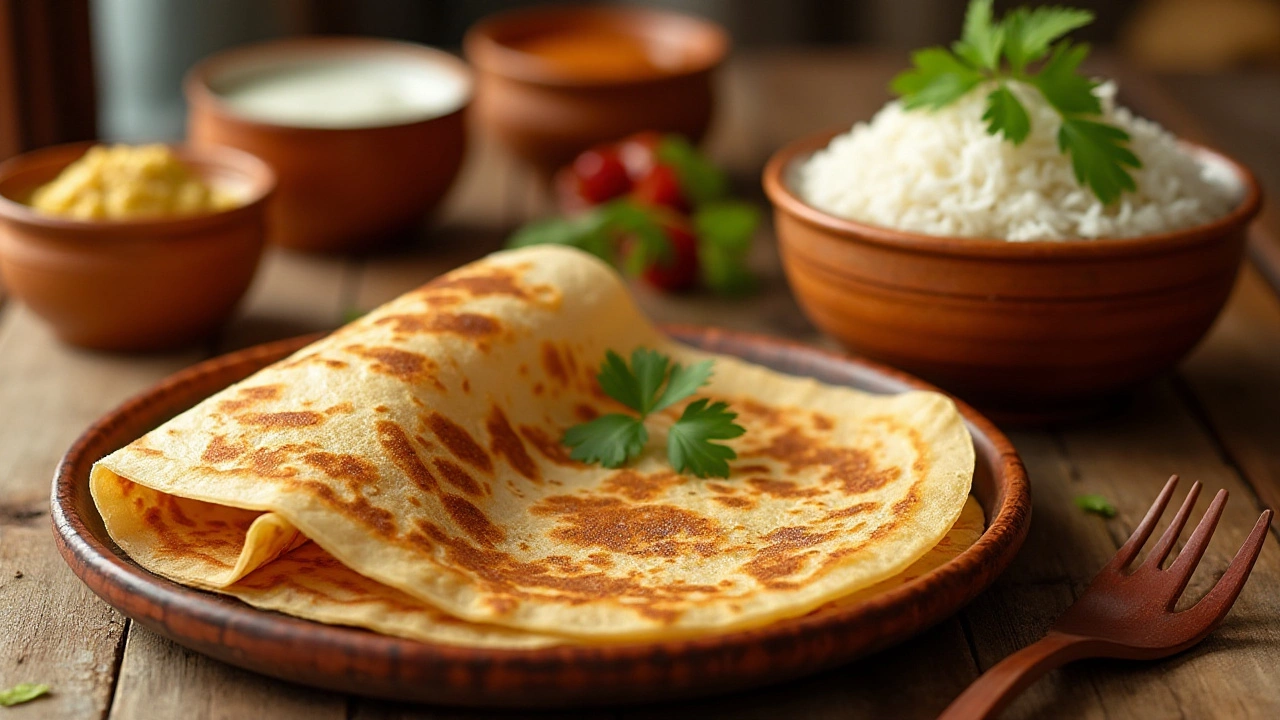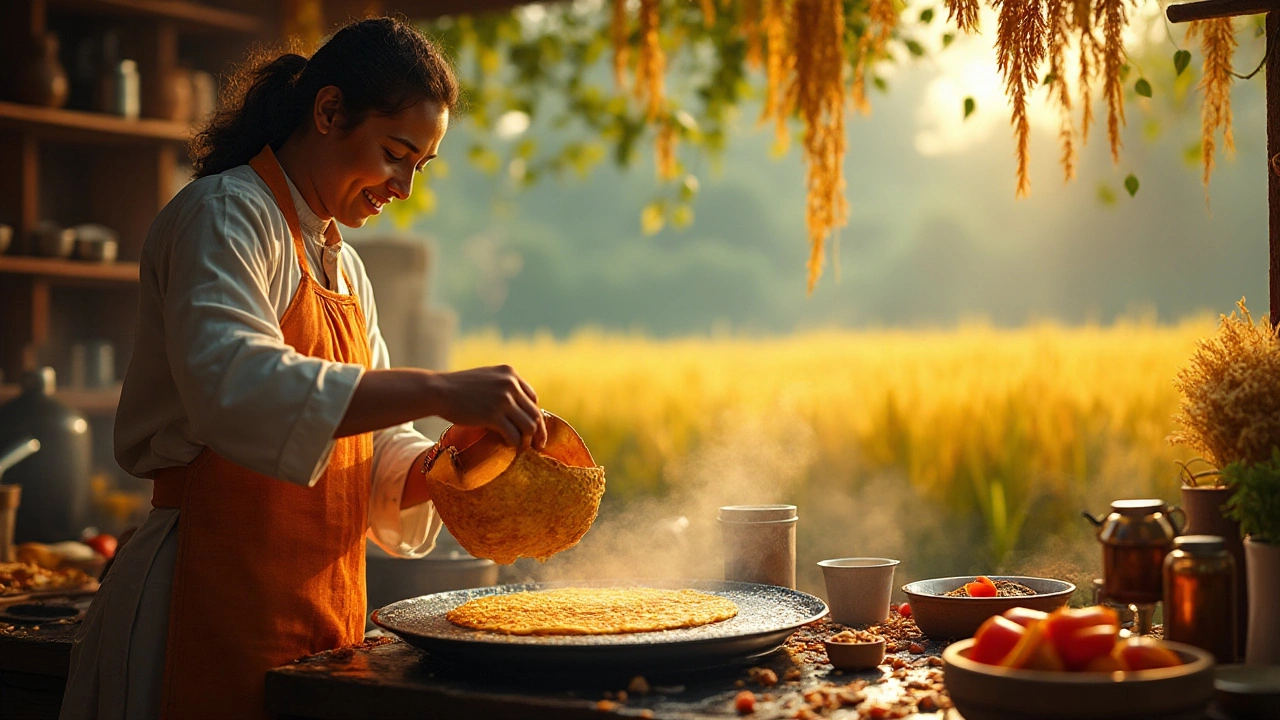In the vibrant world of Indian cuisine, dosa and rice take center stage as staple foods that delight the palate with their subtle flavors and satisfying textures. With similar core ingredients, these two dishes diverge in their preparation and nutritional value, prompting an ever-relevant debate: is dosa healthier than rice?
To answer this question, we must delve into the details of their nutritional contents and understand the health benefits each offers. Dosa, a fermented delight, brings forth a range of benefits, including aiding digestion through its fermentation process. Meanwhile, rice, with its vast varieties, offers its own charm and sustenance.
From brown to basmati, rice presents its own set of advantages when properly selected and prepared. With our tips for crafting a healthier dosa, including tweaking traditional batter recipes, you can enjoy this beloved dish without compromising your health goals.
- Nutritional Breakdown of Dosa and Rice
- Health Benefits of Dosa
- Rice: Varieties and Nutritional Value
- Tips for Making Healthier Dosa
Nutritional Breakdown of Dosa and Rice
When it comes to comparing the nutritional value of two diet staples like dosa and rice, a deeper dive into their compositions is key. At first glance, both are primarily carbohydrate-centric, providing essential energy. Yet, dosa, crafted from fermented rice and lentils, carries distinct advantages over its counterpart. The fermentation process enriches the dosa batter with beneficial microorganisms, boosting the digestibility and nutritional absorption involved. One might enjoy around 100 calories per medium-sized dosa, with a substantial protein presence due to the lentils, adding value beyond mere carbohydrates.
In contrast, rice, a global staple in its own right, presents a varied nutritional profile depending on its type. White rice is often criticized for being high in glycemic index (GI), which can spike blood sugar levels quickly. Brown rice, on the other hand, maintains its bran and germ, offering more fiber and vital nutrients. Caloric content can range substantially—from 130 calories per half-cup of white rice to a bit more with brown rice, due to the extra fiber and nutrients. A rice dish can satisfy your calorie needs effectively but requires strategic pairing with proteins and vegetables for a balanced diet.
Dosa, with its transformative fermentation, emerges as a gut-friendly option that aids digestion. This well-loved pancake origin marks a culturally significant interplay of taste and health benefits. A celebrated nutritionist once noted,
"The appeal of dosa lies not just in its delightful savor but in its symbiotic relationship with the gut microbiome, enhancing digestive wellness."Such sentiment reminds us of why this dish is a culinary gem across many tables.
While looking at the numbers, it’s insightful to consider a direct comparison of the nutritional aspects through an easy table.
| Nutrient | Dosa | White Rice |
|---|---|---|
| Calories | 100 (Per dosa) | 130 (Half cup) |
| Protein | 4g | 3g |
| Fiber | 1g | 0.5g |
| Fat | 1g | 0.2g |
What stands apart in this comparison is how dosa elegantly brings more to your plate. By pairing dosa with side servings of sambar or chutney, you not only amplify the taste but tackle diverse nutritional requirements. On the flip side, the wonder of rice options retains significance, particularly with variations like basmati or jasmine, while leaving room for additional integration of ingredients.
Health Benefits of Dosa
Dosa, cherished not only for its irresistible taste but also for its impressive health benefits, holds a special place in many South Asian households. One of the primary attributes that makes dosa stand out is its fermentation process. This act of fermentation enhances the dish by increasing its nutritional content, making it a veritable powerhouse of nutrients that are easier to digest and absorb by the body. Fermentation is known to boost the B vitamin content, increase the levels of Vitamin K, and enhance the bioavailability of minerals such as iron, all of which contribute to improving the body's overall health.
The careful blending of lentils and rice to make dosa batter brings a balanced proportion of carbohydrates and proteins to the meal. Known for their high protein content, lentils in dosas pack an excellent dose of this important macronutrient, which fuels muscle growth and repair. The carbohydrates supplied by the rice offer steady energy throughout the day, making dosa an excellent choice for a breakfast item that keeps hunger at bay for longer periods. Additionally, by incorporating a variety of grains like millet or quinoa into the batter, you can enhance the nutritional profile further, catering to a wide array of dietary preferences and needs.
A lesser-known fact about dosa is its potential benefits for individuals monitoring their gut health. The fermentation process supports the growth of beneficial bacteria in the gut, aiding digestion and enhancing nutrient absorption. This can be particularly helpful for those with digestive issues or lactose intolerance as these individuals often find it easier to digest fermented foods. Moreover, since dosa is naturally gluten-free, it extends its versatility to those suffering from gluten sensitivities, providing a tasty and healthy alternative.
"Fermented foods like dosa can act as powerful probiotics, sustaining the diversity of gut microbiota," says Dr. Jane Bennet, a renowned nutritionist.
In the grand tapestry of superfoods, dosa also comes with the advantage of adaptability. By tweaking traditional recipes to include less oil or substituting high-GI rice with lower-GI variants, you can enjoy a version of dosa that aligns with health-conscious choices, keeping your meals hearty yet light. Adding ingredients like spinach, carrots, or beetroot to the batter not only lends vibrant color but also infuses the dish with rich antioxidants that promote cellular health. Incorporating spices such as turmeric, which is known for its anti-inflammatory properties, further elevates its health quotient.
As we explore different ways to enjoy dosa, it's noteworthy to consider the diversity it offers. Whether you enjoy it traditionally with sambar and chutney or experiment with fillings such as avocado and tomatoes, dosa offers endless culinary possibilities while maintaining an admirable nutritional profile. Embracing this beloved dish as part of your regular diet opens the door to enjoying delicious meals loaded with health benefits that cater to the modern wellness-conscious palate.

Rice: Varieties and Nutritional Value
Rice holds the esteemed position of being a global staple, nourishing millions daily with its simplicity and versatility. An astounding diversity of rice varieties exist, each offering unique flavor profiles, textures, and nutritional values. One may start with white rice, the most consumed type, which is milled and polished yet holds less nutritional value compared to its counterparts. Brown rice, often hailed for its higher fiber content and vitamins, maintains its bran and germ, making it a wholesome option. Then there's basmati rice, favored for its fragrant aroma and slender grains, which packs a lower glycemic index, aiding in the regulation of blood sugar levels.
This nutritional landscape doesn't end here. Sticky rice, often seen in Asian cuisines, provides an interesting contrast with higher starch content, but it lacks the appeal of complex nutrients found in other types. Wild rice, technically a grass, makes a unique offer with its earthy flavor and robust nutritional profile, becoming a fine choice for those seeking diverse diets.
Every variety of rice shares the commonality of being a substantial energy source, primarily carbohydrates, yet they differ remarkably in what they can offer to one's diet. Interestingly, substituting processed white rice with brown or wild alternatives presents not only health benefits but culinary pleasures too. Nutrition experts like Marion Nestle often highlight the importance of choosing whole grains:
"Whole grains offer health benefits and can be easily incorporated into everyday meals for flavor and nutrition," advises Marion Nestle.Key to rice's nutritional prowess is its potential when integrated wisely into meals, considering portions sizes and the addition of complementary ingredients.
It's crucial to understand how preparation methods can further influence nutritional value. For instance, rinsing rice can remove excess starch, making it lighter and less sticky, which is often recommended for types like basmati. Steaming or boiling are preferred methods, preserving the grains' nutritional integrity without the need for added fats. Often, rice is paired with vegetables or legumes, providing a complete amino acid profile. Such combinations illustrate how rice's humble nature can be elevated to a nutritious cornerstone in any diet.
Tips for Making Healthier Dosa
Creating a healthier dosa can be both a rewarding and enjoyable culinary journey. While traditional dosa is made from a batter of soaked rice and urad dal, subtle adjustments to the ingredients and preparation method can noticeably amp up its nutritional profile. Start by experimenting with healthier grains, such as brown rice, which retains more fiber and nutrients than its white counterpart. The fiber content not only aids digestion but also contributes to a feeling of fullness, reducing the urge for snacking. Additionally, mixing in other whole grains like quinoa or millet can add a higher protein content, which proves beneficial for those looking to increase their daily intake of this essential macronutrient.
Fermentation is another aspect of dosa that can be optimized for health benefits. According to a study published in the International Journal of Food Sciences and Nutrition, longer fermentation hours can increase the availability of B vitamins in the batter. Aim for a fermentation period of at least 8 to 12 hours, allowing the beneficial bacteria to thrive. This not only imparts a tangy flavor but also makes the dosa easier to digest, a boon for gut health. Using a traditional stone grinder instead of a modern mixer can also preserve nutrients and flavor, although it requires more time and effort.
For those with dietary restrictions, dosa can be customized with gluten-free grains or legumes. Incorporating lentils, chickpeas, or even oats not only alters the texture but also provides additional essential nutrients like iron and folate. Rest assured, the end result is as delicious as it is nutritious. According to Chef Vikas Khanna, a celebrated culinary expert, dosa adaptation is all about preserving flavor while enhancing nutrition:
"A dosa's soul is in its simplicity, and by playing with ingredients, we can honor its tradition while embracing modern dietary needs."
The cooking method plays a crucial role too. Utilize non-stick cookware or a well-seasoned cast iron skillet to minimize the need for oil. When using oil, opt for heart-healthy choices like olive oil or avocado oil, known for their beneficial fatty acids. This not only reduces unwanted calories but also promotes cardiovascular health. You may choose to fortify your dosa batter with additional ingredients like spinach or fenugreek leaves, both known for their rich antioxidant content. The incorporation of spicy green chilies or herbs can boost metabolism while delivering a burst of flavor.
Consider serving your dosa with nutrient-packed side dishes to further elevate its health quotient. Sambar is a classic option, loaded with protein and made from lentils, packed with vegetables to add fiber and vitamins. Coconut chutney can be replaced with a mint-coriander version to lower calorie intake while adding freshness and vitamin K. Keeping portion sizes in check, paired with a colorful salad, can ensure a meal that is both satisfying and balanced. By making these mindful adjustments, you can enjoy dosa as part of a nutrient-dense diet that aligns with modern health-conscious lifestyles.
